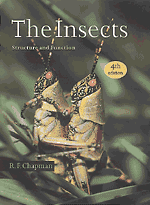Book contents
- Frontmatter
- Contents
- Preface
- Acknowledgments
- PART I The Head, Ingestion, Utilization and Distribution of Food
- PART II The Thorax and Locomotion
- 7 Thorax
- 8 Legs and locomotion
- 9 Wings and flight
- 10 Muscles
- PART III The Abdomen, Reproduction and Development
- PART IV The Integument, Gas Exchange and Homeostasis
- PART V Communication
- Taxonomic index
- Subject index
8 - Legs and locomotion
Published online by Cambridge University Press: 05 June 2012
- Frontmatter
- Contents
- Preface
- Acknowledgments
- PART I The Head, Ingestion, Utilization and Distribution of Food
- PART II The Thorax and Locomotion
- 7 Thorax
- 8 Legs and locomotion
- 9 Wings and flight
- 10 Muscles
- PART III The Abdomen, Reproduction and Development
- PART IV The Integument, Gas Exchange and Homeostasis
- PART V Communication
- Taxonomic index
- Subject index
Summary
Insects typically have three pairs of legs, one pair on each of the thoracic segments. From this, the alternative name for insects, the ‘hexapods’, is derived, although not all hexapods are now regarded as insects.
BASIC STRUCTURE OF THE LEGS
Each leg consists typically of six segments, articulating with each other by mono-or di-condylic articulations set in a membrane, the corium. The six basic segments are coxa, trochanter, femur, tibia, tarsus and pretarsus (Fig. 8.1a).
The coxa is often in the form of a truncated cone and articulates basally with the wall of the thorax. There may be only a single articulation with the pleuron (Fig. 8.2a), in which case movement of the coxa is very free, but frequently there is a second articulation with the trochantin (Fig. 8.2b). This restricts movement to some extent, but, because the trochantin is flexibly joined to the episternum, the coxa is still relatively mobile. In some higher forms there are rigid pleural and sternal articulations limiting movement of the coxa to rotation about these two points (Fig. 8.2c). In the Lepidoptera the coxae of the middle and hind legs are fused with the thorax and this is also true of the hind coxae in Adephaga.
The part of the coxa bearing the articulations is often strengthened by a ridge indicated externally by the basicostal sulcus which marks off the basal part of the coxa as the basicoxite (Fig. 8.3a).
- Type
- Chapter
- Information
- The InsectsStructure and Function, pp. 151 - 184Publisher: Cambridge University PressPrint publication year: 1998
- 3
- Cited by



